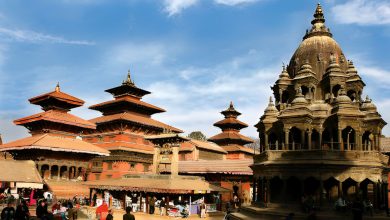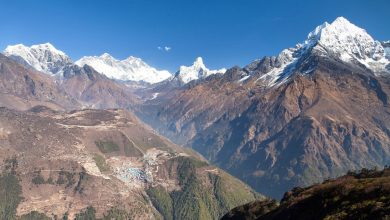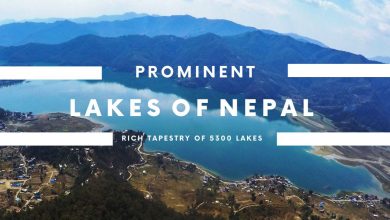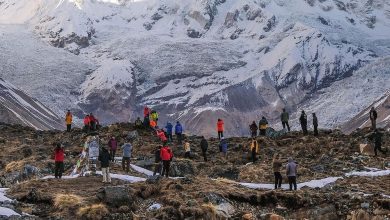12 National Parks Of Nepal: Rich Wildlife and Bio Diversity

Nepal is a stunning country filled with amazing natural beauty and resources. So, to protect such invaluable natural resources, it has established several national parks. The national parks of Nepal are extended from east to west and can be found in all the regions of Nepal; the mountains, the hills, and the plain flat region known as the Terai region.
Furthermore, all the national parks boast unique natural ecosystems, flora, and fauna species. These also have various topographic and climatic conditions, resulting in variations in living beings and vegetation.
Did you know Nepal contains 3.2 percent of floral and 1.1 percent of faunal species worldwide? Yes, you read that correctly, so to preserve, conserve, manage, protect, and sustainably utilize these invaluable resources, national parks are established in Nepal.
Now, let us briefly look at Nepal’s twelve national parks.
Makalu Barun National Park
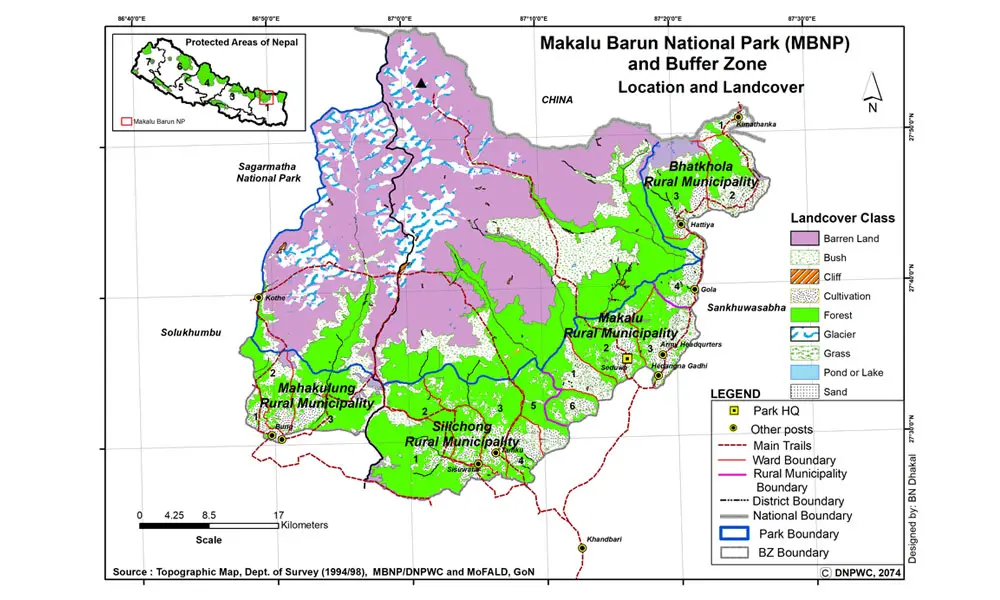
Located in northeastern Nepal, the stunning Makalu Barun National Park covers two major districts of Nepal; Sankhuwasabha and Solukhumbu. If you enjoy the unique ecosystem of mountains, especially the Himalayas, then Makalu Barun National Park is the place to visit. You can find various vegetation here, from sub-tropical forests to alpine.
Suppose we break down the types of vegetation found in Makalu Barun National Park. In that case, you can find 25 species of rhododendron, the national flower of Nepal, 15 different oak species, 86 species of various fodder trees, 48 species of primrose, 48 kinds of orchids, 87 kinds of medicinal herbs, and 19 types of bamboo species.
Also, you can find 400 different species of birds, including the olive ground warbler and the spotted wren babbler. Both of these species are incredibly rare. So, if you are a bird watcher, the Makalu Barun National Park will allow you to witness many avian species.
Talking about wildlife, wild species such as the red panda, Himalayan black bear, snow leopard, wild boar, barking deer, clouded leopard, Himalayan marmot, weasel, langur monkey, ghoral, tahr, barking deer, and serow can be found. Most of the wildlife found in this national park of Nepal is endangered.
The beautiful Arun River flows through the Makalu Barun National Park, and you can even find Salmon there. In addition, the national park has 84 different species of fish.
- Main Method of Accommodation: Camping
- Main Access: Fly from Kathmandu to Tumlingtar accompanied by a six days trek
- Main Activities: Mountaineering and Trekking
- Park Headquarters: Seduwa
- Best Season to Visit: October to November and March to April
Entry Fees:
- Foreigners: 22.56 USD
- SAARC Nations: 11.28 USD
- Nepali Citizens: 0.75 USD
Sagarmatha National Park

Another national park of Nepal in the northeastern part is the Sagarmatha National Park. As the name suggests, this national park is also home to the stunning Mount Everest, the tallest mountain in the world. This national park has also been part of the World Heritage Site since 1979. In addition to Mount Everest, this park boasts several other peaks of Nepal whose height is above 6,000 meters from sea level.
Mostly the Sagarmatha National Park’s altitude is above 3,000 meters, so the terrain you will find there will be very rugged and filled with gorges, glaciers, and humongous rocks. The wildlife found in this region is mouse hare, ghoral, musk deer, Himalayan Tahr, jackal, and weasel. However, if you are lucky, you can also witness snow leopards, Himalayan black bears, lynx, and wolves.
Additionally, there are more than 193 species of birds in the Sagarmatha National Park, like blood pheasant, impeyan pheasant, yellow-billed chough, snow pigeon, red-billed chough, lammergeyer, snow cock, and Himalayan griffon.
The vegetation of this national park differs according to altitude; where in the lower elevation, you can find hemlock and pine trees, while when you go above 3,500 meters above sea level, you will be stunned by the rhododendron, birch, juniper, and silver fir trees. Furthermore, you can see the stunning rhododendrons during the monsoon and spring.
Finally, this place is known for its rich Sherpa culture, tradition, and hospitality. So it is also known for its monasteries and beautiful Sherpa houses.
- Main Accommodation: Hotels, Lodges, Camps, Resorts
- Main Access: Fly from Kathmandu to Lukla usually only thirty minutes
- Main Activities: Mountaineering, Trekking, Observing Sherpa Heritage and Tradition.
- Park Headquarters: Mendalphu, Namche Bazaar
- Best Season to Visit: October to November and March to May
- Entry Fees:
- Foreigners: 22.56 USD
- SAARC Nations: 11.28 USD
- Nepali Citizens: 0.75 USD
Langtang National Park
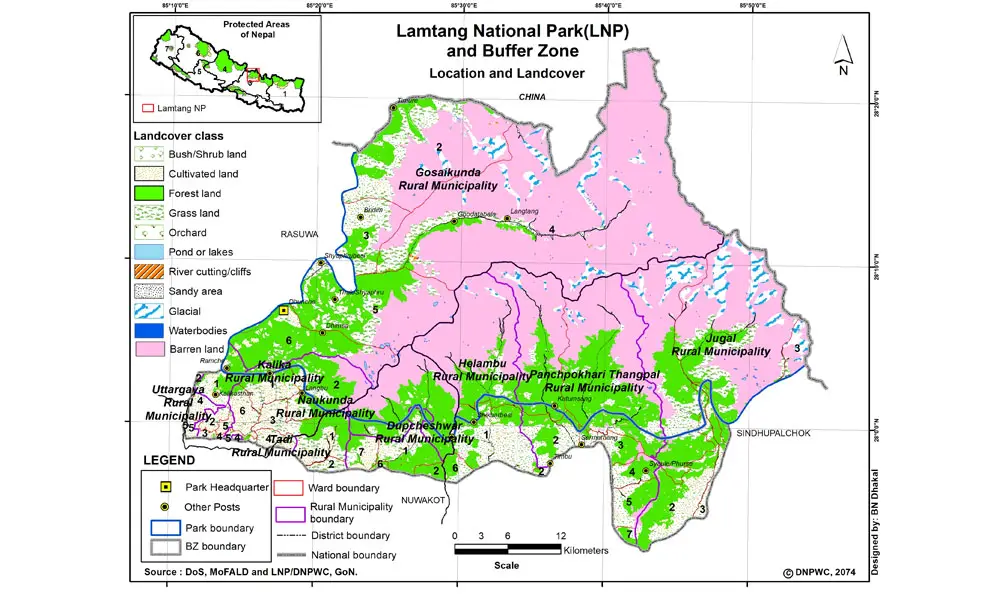
The Langtang National Park was established in 1976. This national park is located north of Kathmandu, the capital city of Nepal. Furthermore, this national park is famous for its lake, Gosaikunda Lake, a holy lake of Nepal, and the gorgeous Langtang Valley.
Langtang National Park is also known for its deep vegetation and deep and beautiful gorges. Talking about the wildlife and birds of this national park, they are Himalayan tahr, pheasants, ghoral, and wild dogs. This national park is flocked by people during Janai Purnima, a festival in Nepal. This festival is celebrated all over Nepal in August.
- Main Accommodation: Lodges and Camps
- Main Access: Travel to Dhunche from Kathmandu and then trek
- Main Activities: Mountaineering, Trekking, Observing Tamang Heritage and Tradition.
- Park Headquarters: Dhunche
- Best Season to Visit: October to November and March to May
Entry Fees:
- Foreigners: 22.56 USD
- SAARC Nations: 11.28 USD
- Nepali Citizens: 0.75 USD
Parsa National Park
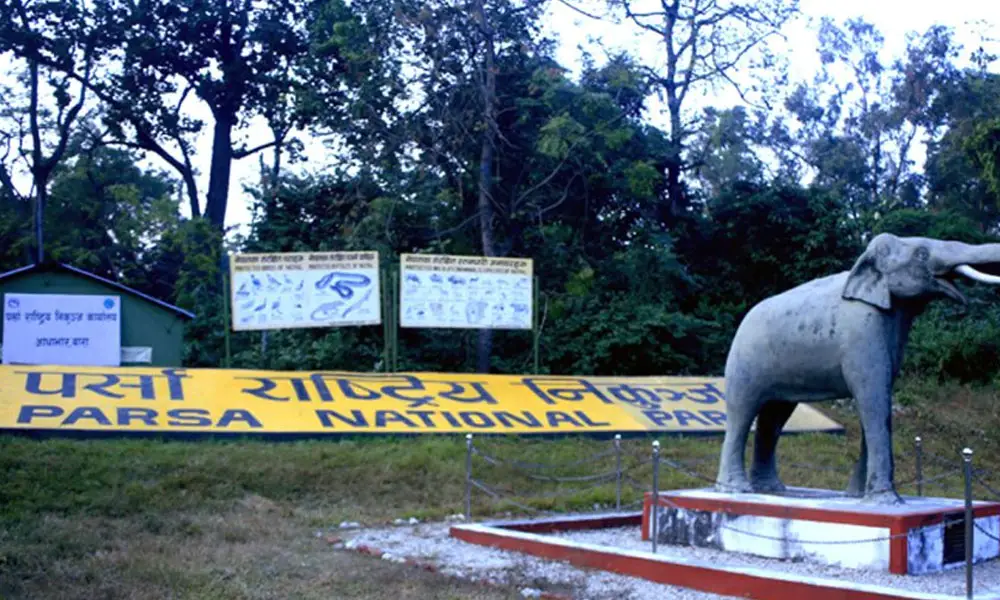
The Parsa National Park covers four different districts of Nepal; Chitwan, Makawanpur, Parsa, and Bara. This national park used to be one of the most famous tiger hunting areas during the royal prosperity in Nepal; however, there are now 41 tigers here which are highly protected.
Let us look at the activities you can enjoy in the Parsa National Park. One activity can be observing the wide variety of wildlife in the region. Some wildlife found in the Parsa National Park is the Royal Bengal tiger, wild dogs, Asian elephants, Sambar deer, sloth bear, jungle cat, palm civet, hog deer, striped hyena, gaur, rat, blue bull, and leopard. Observing these animals can be a real treat while visiting this national park.
Also, the Parsa National Park is home to 527 species of birds. Birds like the large racquet-tailed drongo, white-breasted kingfisher, paradise flycatcher, giant hornbill, peafowl, golden-backed woodpecker, and red jungle fowl can be seen inside the premises of the national park. In addition to the birds, you can also see snakes such as rock python, king cobra, common cobra, and banded krait hiding in the deep vegetation of the national park.
Parsa National Park has a stunning view tower from where you can view the whole national park and bask in its beauty. A Hindu religious relic known as Kailash Bhata is also inside the national park. You can also stay and enjoy the park inside the guest house located inside the national park. In Amlekhgunj, you can also visit an elephant camp and maybe take an elephant bath if that is your thing.
- Main Access: Flying to Simara and then traveling to Adhabar or driving directly to Adhabar from Kathmandu via road.
- Main Activities: Jungle Safari on Elephants, Jeep Drive, Jungle Walks
- Park Headquarters: Adhabar
- Best Season to Visit: October to March and April to June
Entry Fees:
- Foreigners: 11.28 USD
- SAARC Nations: 5.64 USD
- Nepali Citizens: 0.75 USD
Chitwan National Park
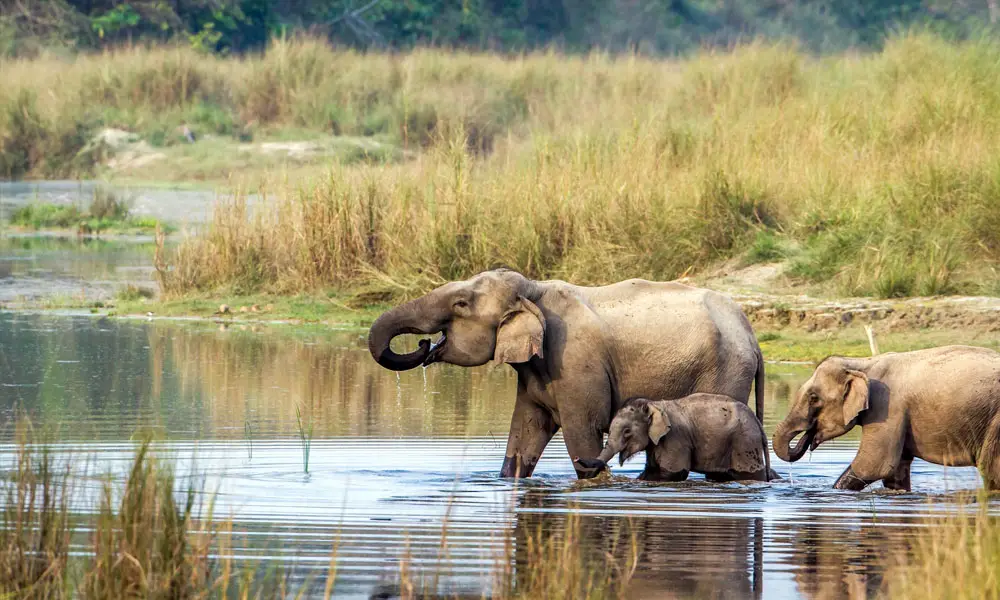
Did you know that Chitwan National Park is Nepal’s most visited and popular national park? Yes, Chitwan National Park is the most famous of all national parks of Nepal, and it is also the first national park of Nepal, established in 1973.
With all these amazing characteristics, Chitwan National Park has been a part of the UNESCO World Heritage Site since 1984. The location of this national park is the south-central part of Nepal and is known for its world-famous Chitwan Jungle Safari. Furthermore, one can regularly witness the beauty of one-horned rhinos and Asiatic elephants inside the national park. And if you are lucky, you can also witness the beauty of the Royal Bengal Tigers.
A famous hunting spot of some famous kings of Nepal, King Mahendra, and Birendra, this national park has an area of 952.63 square km and is adorned by the beautiful Narayani and Rapti rivers. One can also witness the rich customs and traditions of the Tharu people inside the premises and buffer zone of this national park. One can even stay in homestays to get a nearer look inside the warm hospitality of the Tharus of Nepal.
- Main Accommodation: Lodges, Hotels, Homestays, Guest Houses
- Main Access: Travel to Sauraha from Kathmandu Via Plane or By Road
- Main Activities: Jungle Safari on Elephants, Jeep Drive, Jungle Walks, Observing Tharu Culture and Traditions
- Park Headquarters: Kasara
- Best Season to Visit: October to Early March
Entry Fees:
- Foreigners: 15.04 USD
- SAARC Nations: 7.52 USD
- Nepali Citizens: 1.13 USD
Shey-Phoksundo National Park
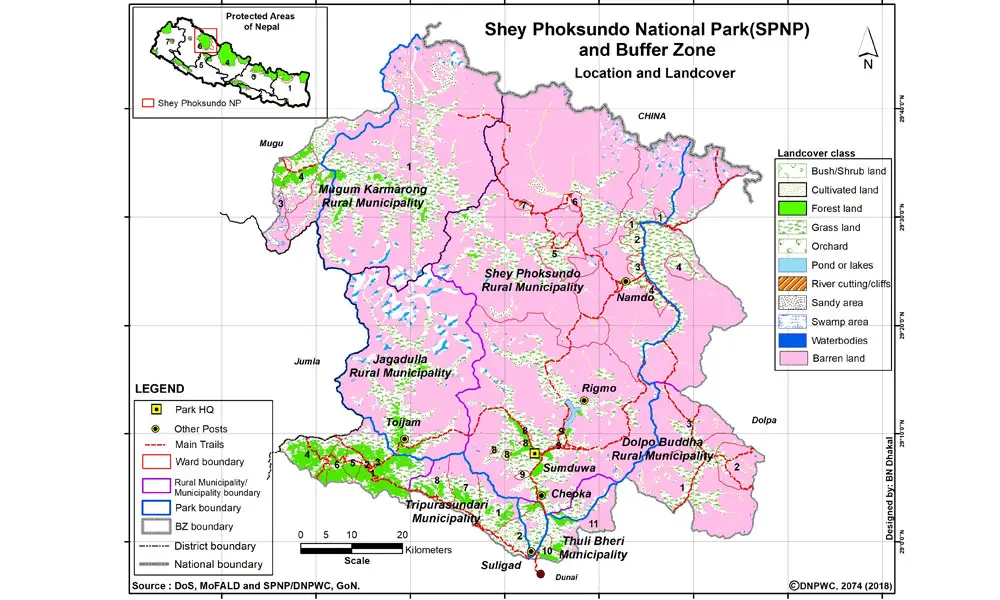
After Nepal’s first established national park, we present you with the largest national park, the Shey-Phoksundo National Park. Home to the world-famous Phoksundo Lake, this national park is famous for its outstanding beauty. Additionally, the stunning Phoksundo Lake is the deepest in Nepal and is 3,611.5 meters or 11,849 feet above sea level. Also, when observing, this lake has a gorgeous blue-green color.
Talking about the faunal beauty of the Shey-Phoskundo National Park, one can often observe animals such as Tibetan yaks, musk deer, blue sheep, and snow leopards lurking in the rich nature of it. Often people visit this national park to trek to the ever-so-popular Phoksundo Lake.
Did you know that more than 9,000 people live inside the premises of the Shey-Phoksundo National Park? Yes, people live inside the national park and follow a special religion known as the Bon Buddhism religion. This religion is a mixture of indigenous Tibetan religion and Tibetan Buddhism. So, get ready to see various Bon Buddhism-related religious relics around the national park once you visit it.
Finally, if you love butterflies, we have some good news for you because Sagarmatha National Park is also home to the gorgeous Paralasa nepalaica butterfly. This butterfly is also the highest-flying butterfly in the world.
- Main Accommodation: Camping
- Main Access: Flying to Jufal, an airport in Dolpa, from Nepalgunj, accompanied by a three-day trek
- Main Activities: Mountaineering and Trekking
- Park Headquarters: Sumduwa
- Best Season to Visit: March to May and September to October
Entry Fees:
- Foreigners: 22.56 USD
- SAARC Nations: 11.28 USD
- Nepali Citizens: 0.75 USD
Banke National Park
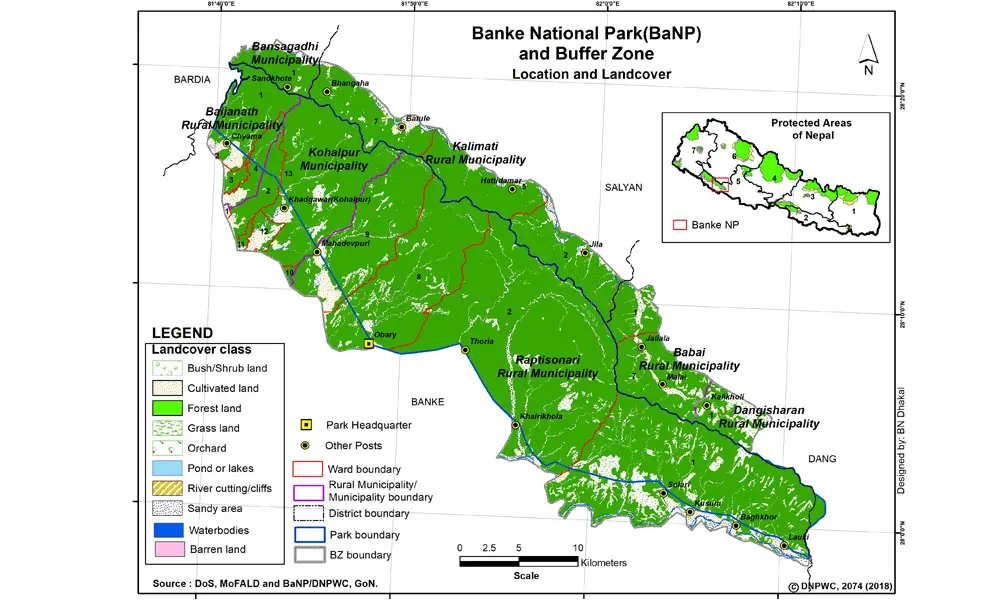
One of the youngest national parks of Nepal, the Banke National Park, was established on July 12, 2010. It has a total area of 550 square kilometers and joins with the famous Bardia National Park to its west. Placed in the Lumbini Province, you can find many hotels near the southern border of this national park.
The main Banke National Park regions are in Nepal’s Dang, Salyan, and Banke districts. The four-horned antelope, Royal Bengal Tiger, and striped hyenas are some of the famous wildlife of this national park.
Did you know that there are a total of eight ecosystems in Banke National Park? Yes, you can see a variation of the ecosystems of Nepal, ranging from the Sal forest and foothills of the Chure range to hardwood forest and Bhabar.
- Main Accommodation: Hotels, Lodges, Home Stays, Resorts, Guest Houses
- Main Access: Drive from Nepalgunj to Banke Headquarter
- Main Activities: Jungle Safari and Homestays
- Park Headquarters: Banke
- Best Season to Visit: Any Season except Monsoons but some visit during Monsoons too.
Entry Fees:
- Foreigners: 11.28 USD
- SAARC Nations: 5.64 USD
- Nepali Citizens: 0.75 USD
Bardia National Park
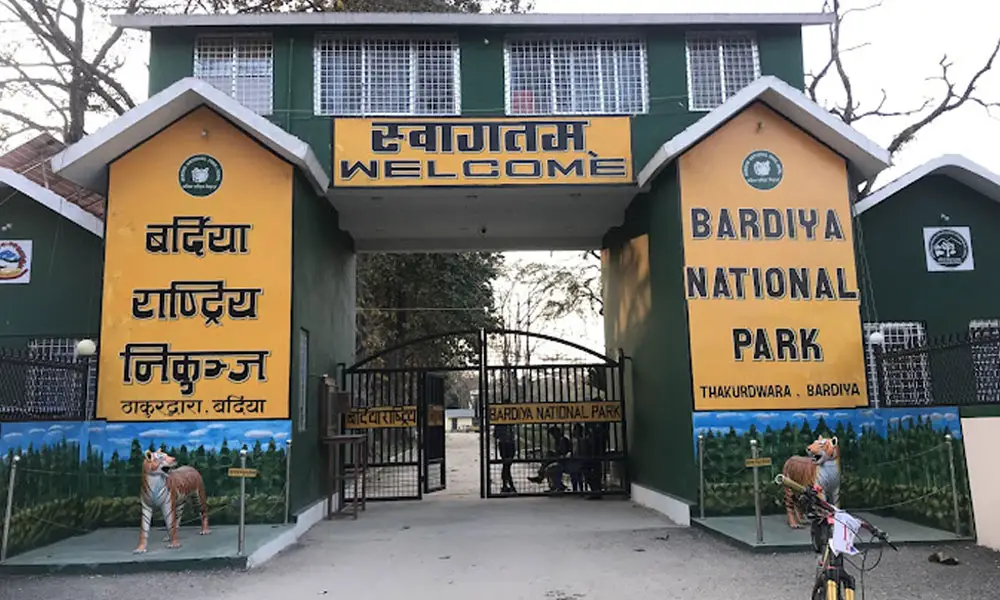
The Bardia National Park was established to preserve the natural beauty of the Terai region of Nepal. It is located in the southwestern part of Nepal. Also, it has an area of 968 square kilometers. With the beautiful sounds of the Karnalai and Babai rivers, the northern part of this national park is adorned by Siwalik Hills.
A range of ecosystems are present in the Bardia National Park of Nepal, ranging from alluvial grasslands to subtropical moist deciduous forests. This national park is in the Tiger Conservation Unit (TCU) Bardia-Banke.
One of the most famous activities in the Bardia National Park of Nepali is Jungle Safari on a jeep. Did you know that this national park has the highest population of tigers in Nepal? Yes, more than 125 tigers are shocking in Bardia National Park, right?
One can go for a fun jungle walk or raft in the Bardia National Park. Also, camping can be one of the fun activities inside the national park.
- Main Accommodation: Hotels, Lodges, Home Stays, Resorts, Guest Houses
- Main Access: Drive from Nepalgunj to Bardia Headquarter
- Main Activities: Jungle Safari and Homestays
- Park Headquarters: Bardia
- Best Season to Visit: Any Season except Monsoons, but some visit during Monsoons too.
Entry Fees:
- Foreigners: 11.28 USD
- SAARC Nations: 5.64 USD
- Nepali Citizens: 0.75 USD
Rara National Park
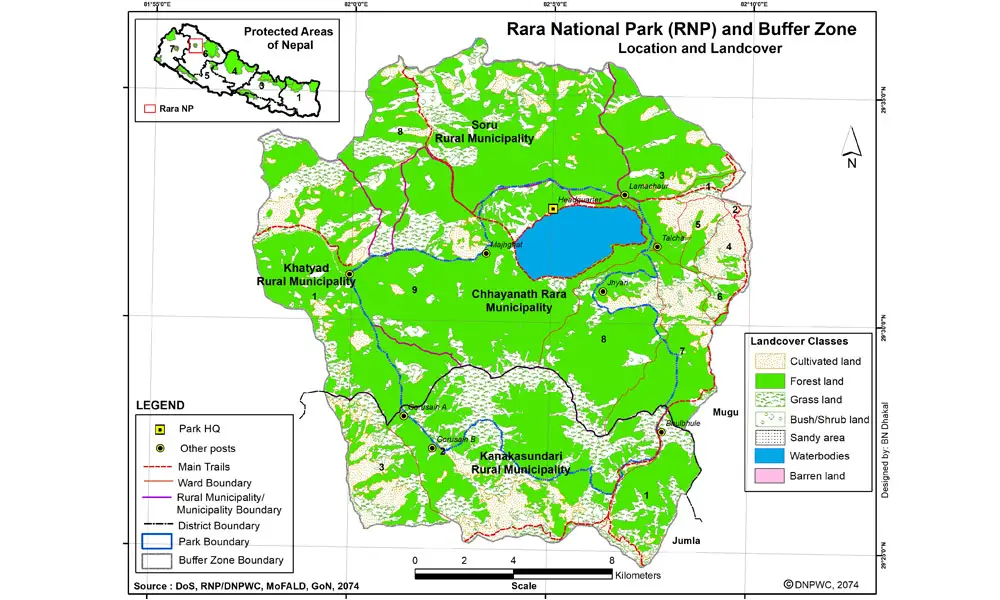
Often known as heaven on earth, the Rara National Park is the smallest national park in Nepal. It was established in 1976. Mugu and Jumla are the two districts in which the national park is placed, and it has an area of 106 square kilometers. The altitude range of this national park is from 2800 meters to 4039 meters.
Many rare yet beautiful fauna and flora are found inside the Rara National Park. There are 210 species of birds in this national park. Birds such as red-crested pochard, black-necked grebe, and common teal are found here. Similarly, there are twenty species of mammals in Rara National Park. Animals such as Himalayan tahr, leopard, musk deer, red panda, jackal, and langur are found in this region.
However, this national park’s most famous natural scenario is Rara Lake, where boating, fishing, and camping are some famous activities. Many also visit this national park to take in the unique cultural and traditional relics. People also visit this national park to participate in adventurous trekking.
One can also find famous religious monuments such as Thakurnath Mahadev, Rara Mahadev, Rinmokshhya, Chhayanath, and Chhapru Mahadev present in the Rara National Park.
- Main Accommodation: Camping, Hotels
- Main Access: Direct flight from Kathmandu to Jumla, accompanied by two-day trekking.
- Main Activities: Trekking and Camping
- Best Season to Visit: Any Season except the Winter Season
Entry Fees:
- Foreigners: 22.56 USD
- SAARC Nations: 11.28 USD
- Nepali Citizens: 0.75 USD
Khaptad National Park

The Khaptad National Park is named after Khaptad Baba in the far western part of Nepal. Khaptad Baba was a Hindu religious leader who came to the national park of Nepal during the 1940s. So, many people visit the Khaptad National Park yearly as a pilgrimage and to show homage to the renowned Khaptad Baba Ashram.
Further, inside this national park, activities such as slaughtering animals, drinking alcohol, and smoking are completely banned. Other religious points of interest are inside the Khaptad National Park, like Saileswari, a famous historical town home to numerous Hindu temples. There is also Ramaroshan which is thought to be associated with Parvati, a Hindu goddess. Places like Surma Sarovar and Badimalika are also present here.
One can find stunning rolling hills and a magnificent view of the Himlayas inside the Khaptad National Park.
- Main Accommodation: Camping
- Main Access: Catch a Flight from Kathmandu to Nepalgunj, then from Nepalgunj to Chainpur, and trek for three days or Drive or fly to Dhangadhi from Kathmandu the drive to Silgadi accompanied by one day trek
- Main Activities: Trekking
- Best Season to Visit: March To May and October To November
Entry Fees:
- Foreigners: 11.28 USD
- SAARC Nations: 3.76 USD
- Nepali Citizens: 0.75 USD
Shuklaphanta National Park
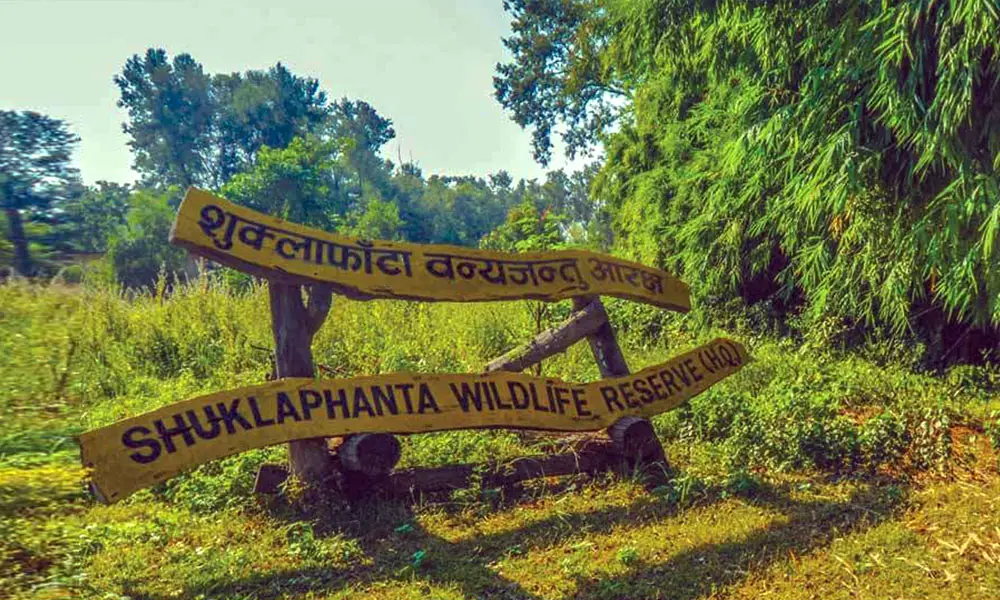
The Shuklaphanta National Park was established in 1984 in the southwestern part of Nepal. It is well-known for its sub-tropical jungle, open grasslands, waterholes, Sal forests, and marsh vegetation.
During its establishment, the Shuklaphanta National Park was a hunting reserve later converted to a national park, especially for protecting swamp deer. Now it is the home of more than 2,000 swamp deer, thirty tigers, and fifty elephants. Other animals include wild boars, leopards, jackals, langurs, rhesus monkeys, blue bulls, barking deer, hog deer, and spotted deer.
You can also find birds such as swamp francolin, grass owls, flycatchers, Bengal Floricans, and others in the Shuklaphanta National Park. Reptiles like crocodiles, pythons, cobras, and marsh muggers are also found here.
- Main Accommodation: Lodges
- Main Access: Catch a Flight or Go via the Road from Kathmandu to Dhangadhi. From there, Drive towards the National Park.
- Main Activities: Elephant Rides
- Best Season to Visit: October to March
- Park Headquarters: Kanchanpur
Entry Fees:
- Foreigners: 11.28 USD
- SAARC Nations: 5.64 USD
- Nepali Citizens: 0.75 USD
Shivapuri- Nagarjun National Park
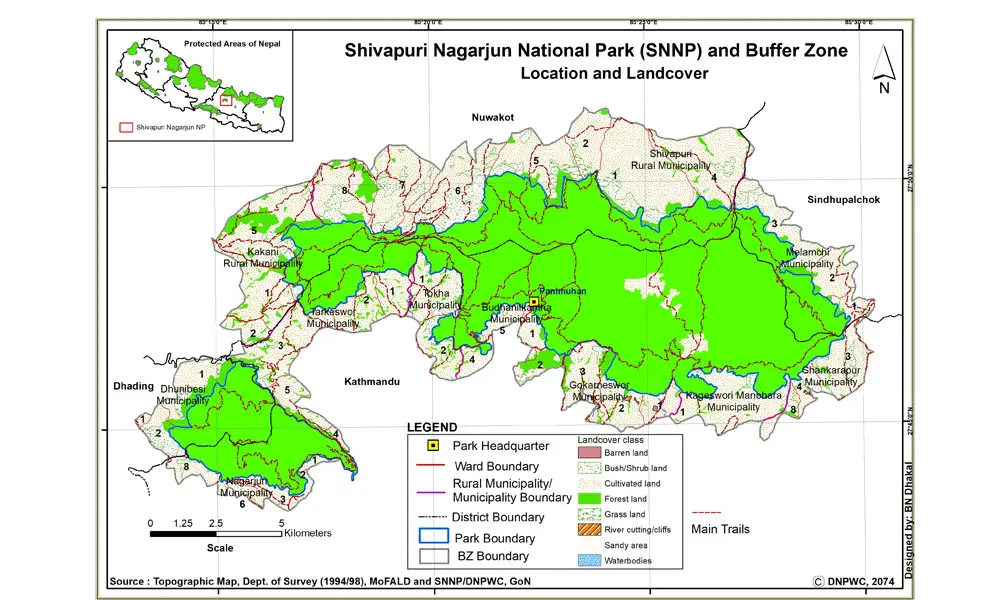
The Shivapuri-Nagarjun National Park is situated near Kathmandu Valley. It is a popular national park established in 2002, and one can find a staggering 129 species of mushrooms inside the premises of the national park. There are also 19 species of mammals, including wild boar, wildcat, rhesus monkey, langur monkey, Himalayan black bear, leopard, and barking deer.
Most people go to the Shivapuri-Nagarjun National Park for hiking, recreational activities, and trekking. The park also has 102 species of butterflies and 177 species of birds.
- Main Access: Drive from Kathmandu to Budhanilkantha area
- Main Activities: Bird Watching, Hiking, and Rock Climbing
- Best Season to Visit: September to May
- Park Headquarters: Shivapuri
Entry Fees:
- Foreigners: 7.52 USD
- SAARC Nations: 4.51 USD
- Nepali Citizens: 0.75 USD
These are all the twelve national parks of Nepal.
You may also like:
